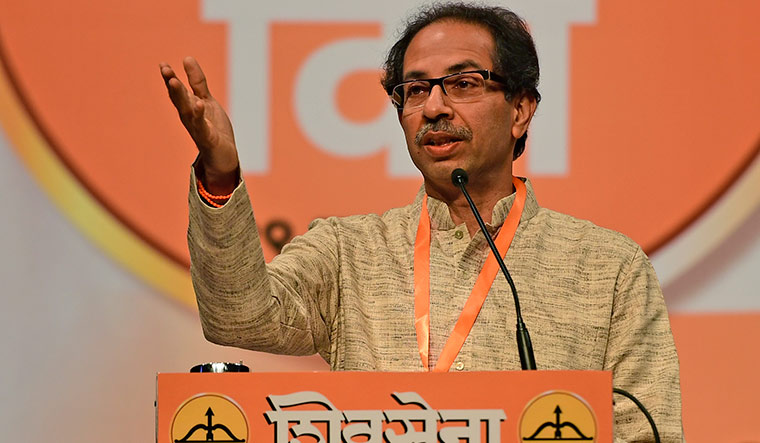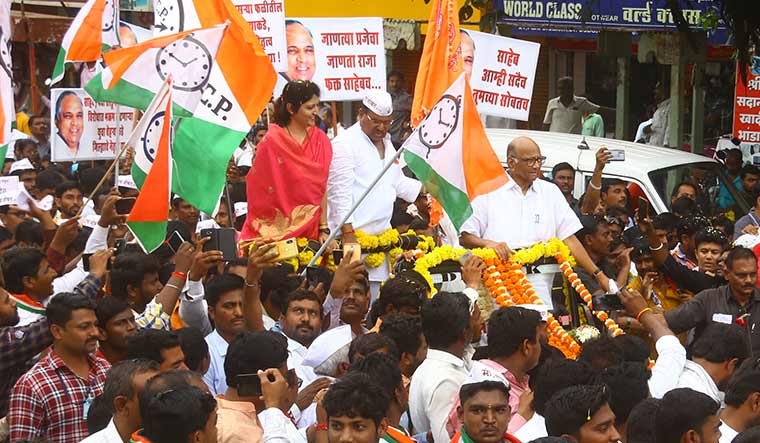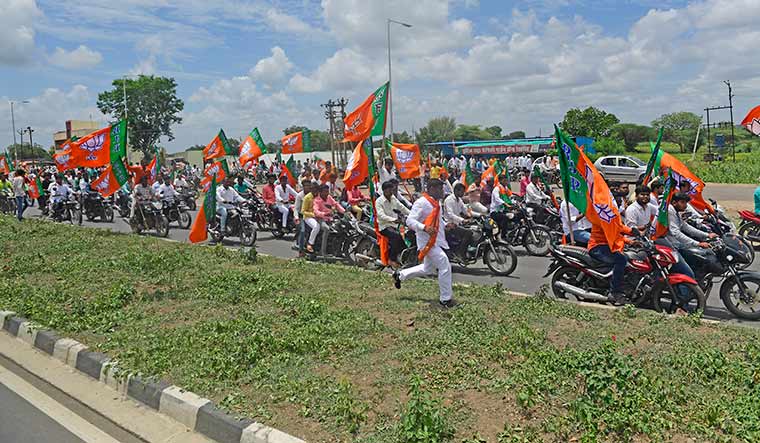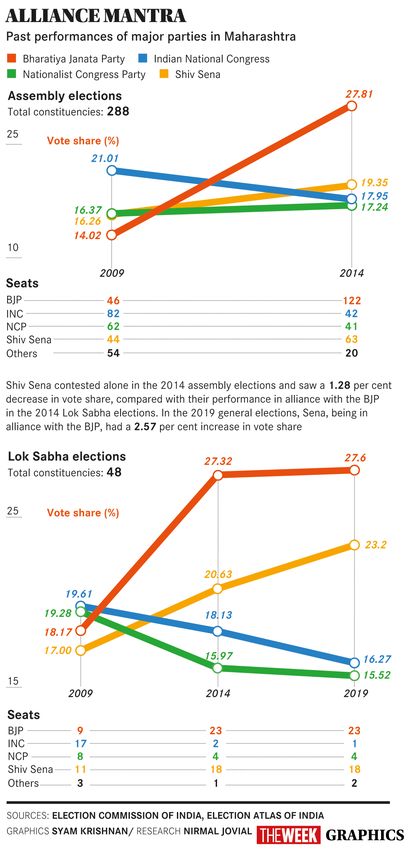Winning the assembly elections in Maharashtra and Haryana will make the BJP stronger in Parliament. Come 2020, and eight Rajya Sabha seats—six from Maharashtra, including the one held by Nationalist Congress Party president Sharad Pawar—will fall vacant. If the BJP is able to win both the states by a good margin, it would win at least five seats in the upper house, thereby significantly boosting the Union government’s ability to pass crucial bills.
A Congress victory, on the other hand, will not only improve its Rajya Sabha numbers, but also help revive the grand old party at the national level. Having Mumbai, India’s financial capital, under its control can revive the Congress and the NCP organisationally as well.
Such an outcome, however, looks improbable. Maharashtra Chief Minister Devendra Fadnavis is so confident of returning to power that, a day before he ended his Maha Janadesh Yatra, he declared that the BJP would soon launch a vijay yatra (success tour). “The yatra will end only after we succeed in hoisting the flag of the BJP-led grand alliance in the Maharashtra legislature,” said Fadnavis in Nashik.
The Maha Janadesh Yatra covered more than 150 assembly seats across the state in three phases. “We will win 90 per cent of these constituencies,” Fadnavis told THE WEEK.
A tall claim? Perhaps. But there is no doubt that Fadnavis, 49, has played his cards well. In 2014, when the relatively young legislator from Nagpur with no ministerial experience was sworn in as chief minister, everyone expected him to be overwhelmed by the responsibility of running a debt-ridden state plagued by droughts and agrarian crisis.
Five years since, not only has Fadnavis survived, but he has also checkmated his party rivals and the opposition. His vision, intellect, oratorial skills and genuine desire to solve problems have helped him gain a firm grip on the wheels of the administration.
The only time Fadnavis appeared to have been slipping was in 2017, when the Maratha agitation for reservation was at its peak. A perception was being created that Fadnavis, a Brahmin, was not receptive to the demands of the politically powerful Maratha community, which make up more than 30 per cent of the state’s population. Early that year, BJP president Amit Shah came close to replacing him as chief minister. What tilted the balance in Fadnavis’s favour was his clean image, integrity and the backing of Prime Minister Narendra Modi.
“Fadnavis’s biggest strength is his cleverness and clean image,” said a senior Congress leader. “Unfortunately we have not been able to project any leader who can take him on. It is not that his government is not battling corruption scandals. A number of ministers are facing corruption charges, but Fadnavis has succeeded in projecting that he is standing tall above all the mess.”
An NCP leader in Pune narrated how a big builder from the city went to Mumbai to meet Fadnavis, after some pending files related to his company were cleared by the government. The builder wanted to give Fadnavis a token of his gratitude, but Fadnavis, sensing it, told him bluntly that he did not want anything. “If you really want to give something, then contribute to our party fund,” said the chief minister.
Fadnavis has smoothly established the BJP’s supremacy over the opposition and the Shiv Sena, its coalition partner. He has outwitted the likes of Pawar of the NCP, and Prithviraj Chavan and Ashok Chavan of the Congress, while reducing the Sena to being a junior ally.
Fadnavis moves are carefully crafted. A case in point is an incident in 2017, when the Maratha agitators were taking out silent marches. Babanrao Lonikar, a minister from Marathwada, told Fadnavis that he sympathised with the cause, as he was a Maratha himself. Fadnavis apparently told Lonikar that he was free to join the agitation. “I will not hold it against you. I respect your views,” said Fadnavis.
Lonikar took part in the very next silent march, not as minister but as a Maratha. His presence sent a signal to the community that the government was sympathetic to its cause.
According to political commentator Abhay Deshpande, Fadnavis’s biggest achievement as chief minister was to end the policy paralysis that had gripped the state when the Congress-NCP coalition was in power. “Following Modi’s style, Fadnavis took quick decisions, reacted to crisis situations in a proactive manner, took steps to tackle agrarian crisis and boosted infrastructure development in urban areas,” said Deshpande.
As a politician, he said, Fadnavis’s biggest accomplishment was that he ran a smooth government even when the Shiv Sena was in the opposition in the initial weeks of his government. “He really understood what Uddhav expected from the government,” said Deshpande. “Having understood that, he took efforts to build ties with the Sena leadership.”
Apparently, it was Fadnavis who told Uddhav that his son, Aditya, should not contest the Lok Sabha elections this year. According to a source, Fadnavis told the Sena leadership: “Let him gain experience in Maharashtra first. Let him learn the functioning of the state cabinet here.”
Madhav Bhandari, chief spokesperson of the BJP’s Maharashtra unit, said the Fadnavis government’s achievements could be broadly classified into three segments. “First, he did not allow any sort of social or communal tensions in the state,” he said. “When extreme left elements tried to stoke caste tensions over issues like the Bhima-Koregaon agitation, the chief minister acted promptly to make sure that the state remained calm. Second, a range of decisions to tackle agrarian distress was taken. A huge loan waiver was announced, in spite of the fact that he knew that waivers cannot be a permanent solution.”
According to Bhandari, the waiver and its speedy implementation left the opposition stumped. “Third, the amount of FDI that Maharashtra was able to attract could only have been possible because of the industry-friendly policies of the chief minister,” he said.
Nitin Birmal, professor of political science and the Maharashtra coordinator of the Centre for Study of Developing Societies, said there was no visible anti-incumbency against the state government. “People seem, by and large, satisfied with the Fadnavis government,” he said. “The performance cannot be called extraordinary, [because] the government has not taken any decisions that, in the long term, will solve problems like agrarian distress and industrial expansion. But people seem satisfied with the short-term measures that the state government has taken, with help from the Centre, in key sectors.”
Together, the BJP and the Shiv Sena hope to win more than 200 of 288 seats in the assembly. Fadnavis’s biggest challenge, however, is keeping the saffron alliance intact. Before the Lok Sabha elections, it was Fadnavis who convinced the BJP’s national leadership that an alliance with the Sena was a must. “Hindutva is the thread binding the two parties,” he told the party leadership. “Our vote bank should not split.”
With the BJP having scored a massive victory in the Lok Sabha polls, some party leaders are now talking about showing the Sena its place. Water Resources Minister Girish Mahajan recently claimed that he could ensure victory for the BJP in 80 seats. “We shall win the remaining 70-80 seats elsewhere and can come to power on our own,” he said.
The comment drew sharp reactions from the Sena. Transport Minister Diwakar Raote said that, when it comes to seat- and power-sharing, the Sena would not settle for anything less than 50 per cent. Sena leaders even talk about sharing the chief minister’s post for two and a half years each. Fadnavis, however, told THE WEEK that there is no such plan under consideration (see interview on page 38).
As of now, the parties are discussing a formula by which the BJP would contest in 162 seats and the Sena in 126. Both the parties would then allot seats to smaller allies. For the Congress and the NCP, the big hope is that the saffron alliance would break, helping them bag around 40 seats.
The opposition camp, however, is not much hopeful.
The Congress has been steadily losing its stalwarts to the BJP. On September 11, ex-minister Harshvardhan Patil quit the Congress for the BJP. Patil had been minister for 19 years—from 1995 to 2014—and was considered a potential chief minister candidate. He quit after the NCP refused to concede the Indapur assembly seat to him, and his daughter Ankita was denied chair of an important local body committee. Patil is the second heavyweight to quit the Congress. The first was Radhakrishna Vikhe Patil, former leader of the opposition in the assembly, who joined the BJP this June.
Nearly two dozen leaders of the Congress and the NCP, mostly in western and southern Maharashtra, have either quit or are on their way out. “It is a great loss not because these leaders were stalwarts, but because each of their seats were winnable seats,” said a senior Congress leader. “If the BJP is facing a problem of plenty, we are facing a problem of scarcity.”
In the absence of able leaders, the Congress has failed to mobilise grassroots support. Its Pol Khol (exposé) Yatra has so far not been able to draw huge crowds.
Meagre resources also pose a big challenge. “In terms of funds, the BJP has huge resources,” said former chief minister Prithviraj Chavan. “We will have to counter it by fighting the election in the lanes and bylanes of every constituency, and engaging with voters heart-to-heart.”
The Congress and the NCP have decided to put aside their differences and fight a do-or-die battle. “We will reach out to all voters and make them aware that more than 16,000 farmers have killed themselves in the past five years,” said Satej Patil, Congress leader and former minister. “Marathwada faces a severe drought while massive floods have swept away the homes of thousands in western Maharashtra. Economic recession is setting in and nearly 4.5 million youth are unemployed. There is silent anger among the people.”
Congress spokesperson Sachin Sawant said that more than half the farmers in the state had not benefited from the Rs34,000-crore loan waiver. “As per the latest data, more than 44 lakh farmers got waivers worth Rs18,761 crore,” he said. “This means nearly 45 lakh farmers have been left out.”
Congress leader Ratnakar Mahajan said as many as 20 ministers in the Fadnavis cabinet are facing allegations of corruption. “The list begins with Pankaja Munde, and includes Shiv Sena ministers, too,” he said. “Senior journalist P. Sainath has pointed out that the crop insurance scheme (Fasal Bima Yojana) is a huge scam. This government has been a total failure and we will highlight each of its misdeeds in our campaign.”
The Congress and the NCP have agreed to contest 125 seats each, leaving the remaining 38 seats for junior allies. Leading the opposition battle is Sharad Pawar, 78, who is on a whirlwind tour to rebuild the NCP in all districts.
Pawar has asked NCP leaders to field as many new faces as possible. “I want to hand over the reins to the young generation,” he said at a rally in Nanded. “Those who left us claim that they did so for the sake of developing their constituencies. So, what were they doing when they were in power for 15 years with us?”
The NCP hopes that around 30 of its incumbent MLAs would get reelected. The challenge is to win 30 of the remaining 95 seats it plans to contest. “We have set a target of 60 to 65 seats,” said state NCP president Jayant Patil.
Balasaheb Thorat, who recently took charge as state Congress chief, wants all district presidents to screen all ticket aspirants and recommend only those who have a clean track record. “Close to 75 per cent of our tickets will be given to young leaders,” said Nana Patole, the Congress’s campaign committee chief.
The NCP wanted to have Raj Thackeray’s Maharashtra Navnirman Sena on board, but the Congress’s national leadership was apparently not too keen. Though the chances of such a tie-up now appear slim, some sort of understanding over a few seats is likely. Raj Thackeray is also reportedly planning to field candidates from 100 seats.
What could hurt the Congress-NCP alliance is its inability to join hands with Prakash Ambedkar’s Vanchit Bahujan Aghadi. In the Lok Sabha elections this year, the alliance between the VBA and the All India Majlis-e-Ittehadul Muslimeen had cost the Congress and the NCP eight seats.
The Congress, for its part, had tried hard to woo the VBA, but Ambedkar demanded that it first severe ties with the NCP. According to Thorat, the condition was “ridiculous”. “We will not break our alliance with the NCP,” he said. “It has been one of our oldest allies.”






